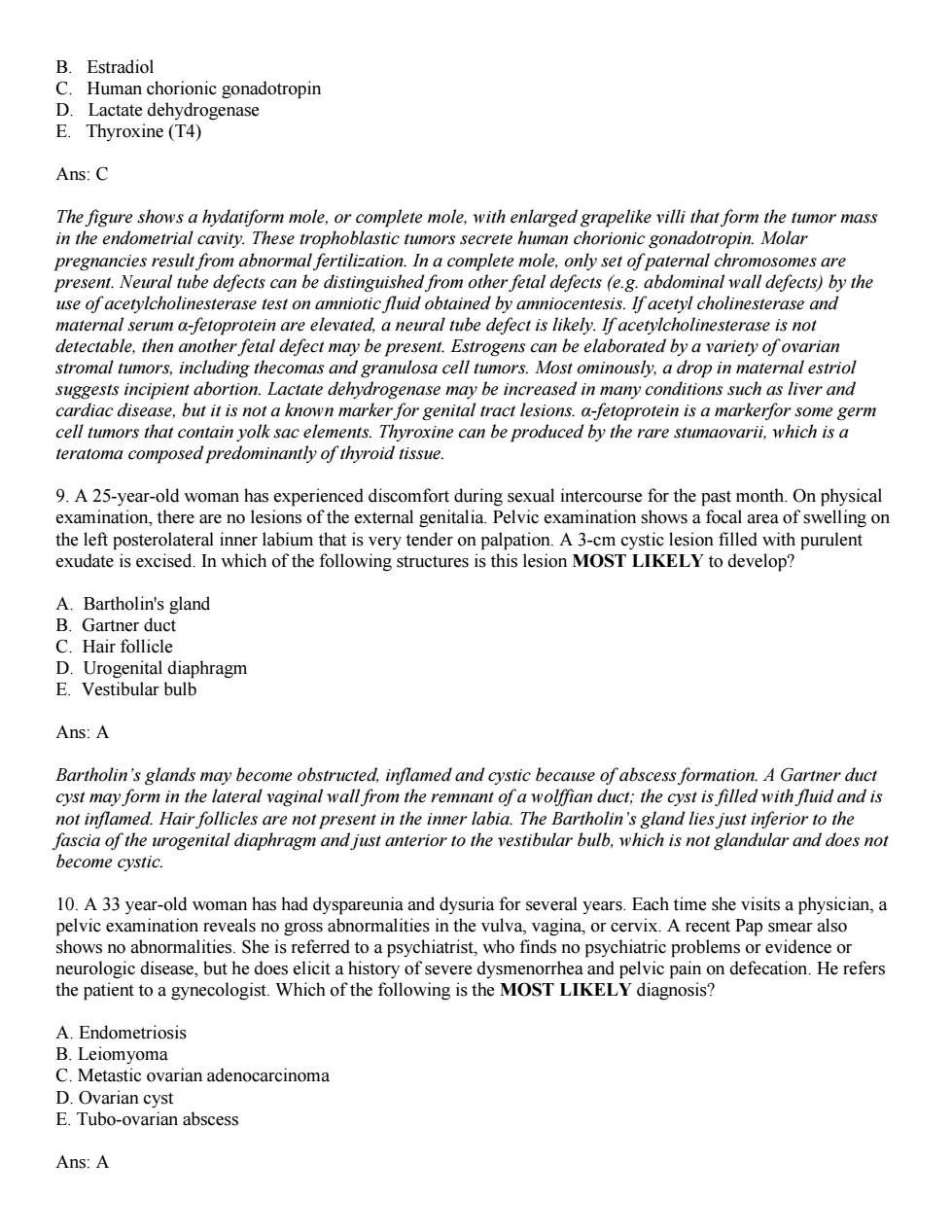正在加载图片...

B.Estradiol Lactate genase E Thyroxine(T4) Ans:C The figure shows a hydatiform mole.or complete mole,with enlarged grapelike villi that form the tumor mass in the endometrial cavity.These trophoblastic tumors secrete human chorionic gonadotropin.Molar pregnancies result from abnormal fertilization.In a complete mole,only set of paternal chromosomes are present.Neural tube defects can be distinguished from other fetal defects (e.g.abdominal wall defects)by the use of acetylcholinesterase test on amniotic fluid obtained by amniocentesis.If acetyl cholinesterase and maternal serum a-fetoprotein are elevated.a neural tube defect is likely.If acetylcholinesterase is not detectable.then another fetal defect may be present.Estrogens can be elaborated by a variety of ovarian stromal tumors,including thecomas and gramulosa cell tumors.Most ominously.a drop in maternal estriol pient abortion.Lactate dehvdr nay he increased in m ns such as liver and se,but it is ot a knoy ital tract lesions nors that c protein isam ne can be produ ed by the teratoma composed pre minantly of thyroid tissu 9.A 25-year- ysical xamination,there a ons o1 examination show area of swe ng or the left posterolateral inner labium that is very tender on palpation.A 3-cm cystic lesion filled with purulent exudate is excised.In which of the following structures is this lesion MOST LIKELY to develop? A.Bartholin's gland B.Gartner duct C.Hair follicle D.Urogenital diaphragm E.Vestibular bulb Ans A Bartholin's glands may become obstructed,inflamed and cystic because of abscess formation.A Gartner duct cyst may form in the lateral caginal wall fro the ren ant of a wolffian duct:the cyst is filled with fluid and is not inflamed.Hair follicles not pre. ent in the inne The B tholin's gland lies rogenal diaphragm and just anterior to the which i s not gla 10.A 33 year-old womar has had dyspareuniaand dysuria for several years.Each time she visits a physician,a pelvic exa ent Pap smear also shows no al inthe who tinds no psychiatrie problems or evidence or to a psychiatrist, neurologic disease,but he does elicit a history or severe dysmenorrnea an d pelvic pain on defecation.He refers the patient to a gynecologist.Which of the following is the MOST LIKELY diagnosis? A.Endometriosis B.Leiomyoma C.Metastic ovarian adenocarcinoma D.Ovarian cyst E.Tubo-ovarian abscess Ans:AB. Estradiol C. Human chorionic gonadotropin D. Lactate dehydrogenase E. Thyroxine (T4) Ans: C The figure shows a hydatiform mole, or complete mole, with enlarged grapelike villi that form the tumor mass in the endometrial cavity. These trophoblastic tumors secrete human chorionic gonadotropin. Molar pregnancies result from abnormal fertilization. In a complete mole, only set of paternal chromosomes are present. Neural tube defects can be distinguished from other fetal defects (e.g. abdominal wall defects) by the use of acetylcholinesterase test on amniotic fluid obtained by amniocentesis. If acetyl cholinesterase and maternal serum α-fetoprotein are elevated, a neural tube defect is likely. If acetylcholinesterase is not detectable, then another fetal defect may be present. Estrogens can be elaborated by a variety of ovarian stromal tumors, including thecomas and granulosa cell tumors. Most ominously, a drop in maternal estriol suggests incipient abortion. Lactate dehydrogenase may be increased in many conditions such as liver and cardiac disease, but it is not a known marker for genital tract lesions. α-fetoprotein is a markerfor some germ cell tumors that contain yolk sac elements. Thyroxine can be produced by the rare stumaovarii, which is a teratoma composed predominantly of thyroid tissue. 9. A 25-year-old woman has experienced discomfort during sexual intercourse for the past month. On physical examination, there are no lesions of the external genitalia. Pelvic examination shows a focal area of swelling on the left posterolateral inner labium that is very tender on palpation. A 3-cm cystic lesion filled with purulent exudate is excised. In which of the following structures is this lesion MOST LIKELY to develop? A. Bartholin's gland B. Gartner duct C. Hair follicle D. Urogenital diaphragm E. Vestibular bulb Ans: A Bartholin’s glands may become obstructed, inflamed and cystic because of abscess formation. A Gartner duct cyst may form in the lateral vaginal wall from the remnant of a wolffian duct; the cyst is filled with fluid and is not inflamed. Hair follicles are not present in the inner labia. The Bartholin’s gland lies just inferior to the fascia of the urogenital diaphragm and just anterior to the vestibular bulb, which is not glandular and does not become cystic. 10. A 33 year-old woman has had dyspareunia and dysuria for several years. Each time she visits a physician, a pelvic examination reveals no gross abnormalities in the vulva, vagina, or cervix. A recent Pap smear also shows no abnormalities. She is referred to a psychiatrist, who finds no psychiatric problems or evidence or neurologic disease, but he does elicit a history of severe dysmenorrhea and pelvic pain on defecation. He refers the patient to a gynecologist. Which of the following is the MOST LIKELY diagnosis? A. Endometriosis B. Leiomyoma C. Metastic ovarian adenocarcinoma D. Ovarian cyst E. Tubo-ovarian abscess Ans: A